Rosehip & Ginseng Face Cream Recipe
This luxurious face cream features jojoba oil infused with rose petals and helichrysum (immortelle) flowers, along with rosehip seed oil, shea butter and panax ginseng extract.
It was designed especially for skin that’s mature and/or on the dry side.
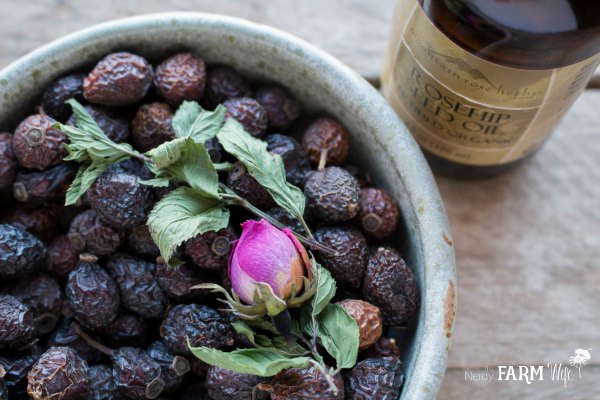
Ginseng Extract is a wonderful item that I discovered a few months ago, while browsing around Bramble Berry’s site.
I did a little research and found some pretty impressive studies on its wrinkle fighting and anti-aging properties! (Studies Link.)
At $2.50 for a 1 ounce bottle, it was the perfect size and price to experiment with, so I threw it in the cart to give it a try. I really like it so far and love how it works in synergy with the other items in this cream recipe!
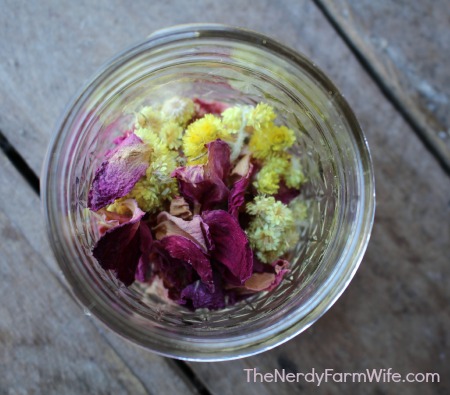
Before making this cream, you can optionally infuse the jojoba oil with your choice of dried flowers or herbs. I decided upon rose petals and helichrysum flowers because they are both lovely in lotions and creams, but you could also consider chamomile, calendula, lavender or any other favorite you might have.
Jojoba oil is on the pricey side, so if it’s not in your budget, try sweet almond, avocado or rice bran oil instead.
Since only a small amount is needed for this face cream recipe, I made up a small jar of infused oil.
To Make the Infused Oil
- Place a pinch of the dried flower(s) or herb(s) you want to use in a small heatproof glass jar.
- Pour in just enough oil to cover the flowers and then set the jar down into a saucepan that contains an inch or two of water.
- Set the pan over a low burner (I use my wood stove) and let it warm gently for a few hours, keeping a close eye on it.
- Strain out the amount you need for the recipe.
Don’t throw out what’s left in the jar! Add a bit more oil to cover the flowers, cap the jar, tuck it in a cabinet and infuse at room temperature for a few more weeks, for use in later projects.
Shelf life of this oil is at least one year, but since jojoba oil itself has a very long shelf life (of several years), it will probably stay fresh for longer than most other types oil infusions.
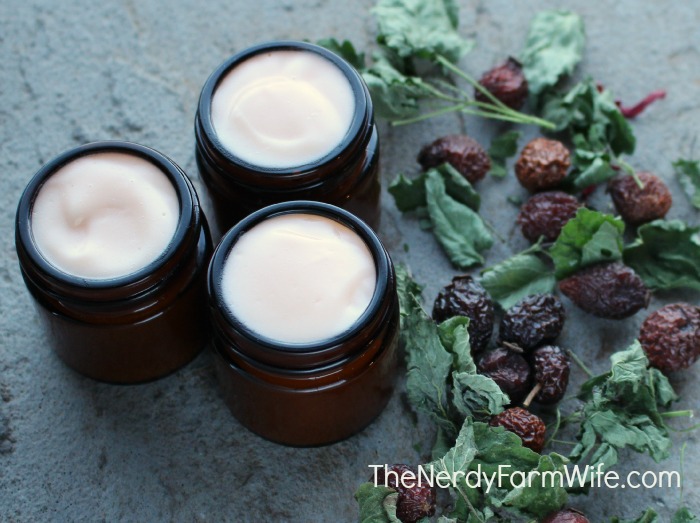
Rosehip & Ginseng Face Cream Recipe
A scale works best for making creams and lotions, so that every batch is consistent and without surprises, but I realize not everyone owns one, so developed this recipe so it can be measured in teaspoons and tablespoons as well.
- 7 g (1/2 tbsp) jojoba oil (infused or plain)
- 7 g (1/2 tbsp) shea (or mango or avocado) butter
- 12 g (1 tbsp) rosehip seed oil
- 9 g (4 tsp) vegetable emulsifying wax
- 75 g (5 tbsp) distilled water
- tiny pinch of alkanet root (optional, for pink color)
- 1/2 tsp (1 g) ginseng extract
- few drops essential oil (see step 3)
- nature-derived preservative (see step 4)
Yield: Fills three 0.85 oz (25 ml) amber glass jars.
Supply Sources
(Links to Mountain Rose Herbs and Bramble Berry are affiliate links. If you click on one and make a purchase, I earn a small commission for sending a customer their way. This costs you nothing extra. Thank you!) :)
I bought my rosehip seed oil, vegetable emulsifying wax and alkanet root at Mountain Rose Herbs.
The jojoba oil, (refined) shea butter, ginseng extract and essential oils came from Bramble Berry.
The nature-derived preservative I like best, Luecidal Liquid SF, came from Lotioncrafter.
Distilled water can be found at your local grocery store.
Jars came from Specialty Bottle.
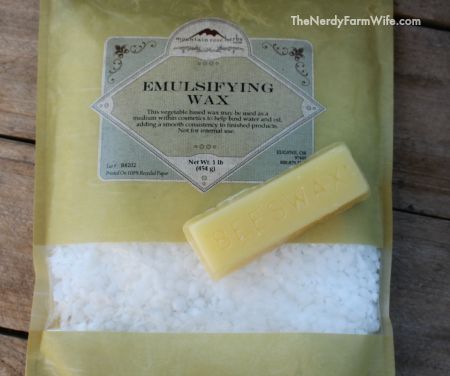
A Note About Emulsifying Wax versus Beeswax
In this recipe, I used emulsifying wax NF, instead of the beeswax used in some of my other recipes. Some versions out there are made from petroleum products or have sketchy additives, which is why I like to only use vegetable-derived Emulsifying Wax NF from Mountain Rose Herbs in my lotion recipes. The “NF” means it’s National Formulary approved, and made to a standardized formula, so any type of “NF” emulsifying wax that you find, should work in a comparable way.
If you don’t want to use emulsifying wax, you can still adapt the same idea of infusing oil and incorporating it into an existing beeswax-based cream recipe (like THIS ONE or THIS ONE), but don’t try to directly substitute beeswax for the emulsifying wax in this particular recipe. It won’t work, because beeswax requires a much higher oil to water ratio to prevent separation issues, which is why beeswax-based lotions and creams are richer and heavier.
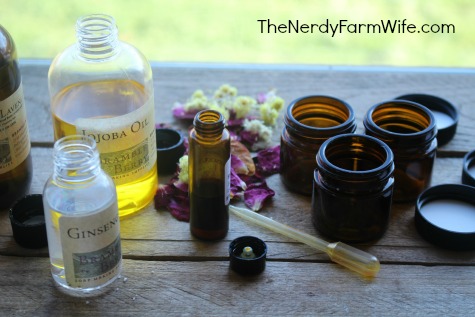
Directions to Make
Step 1:
Combine the jojoba oil, shea butter and emulsifying wax in a heat proof container or small canning jar. Don’t add the rosehip seed oil yet, since it’s a bit more delicate. If you want your lotion lightly tinted pink, add a tiny pinch of alkanet root too.
Weigh the water in a separate jar.
Step 2:
Set both jars down into a saucepan containing an inch or two of water that has been placed over a medium-low burner. Heat the jars and their contents via this indirect heat for around 10 minutes. Turn off the burner, but keep the pan on it.
Add the rosehip seed oil to the oil/butter & wax mixture and let it continue sitting in the still-warm pan for about a minute to warm up.
Step 3:
Pour the melted oil/butter/wax mixture into the hot distilled water. Some of the alkanet root will have settled to the bottom of the container while heating, so pour carefully and leave that layer behind, to avoid speckles in your finished cream.
The combination should immediately turn light pink as the two mixtures meet and the emulsification process begins.
Stir briskly for around 30 seconds, then set aside to cool for 4 or 5 minutes, stirring occasionally for 30 or 40 seconds at a time. If you’d like to speed up the thickening process, you can set the jar of cream down into a bowl of ice water while you stir.
Keep stirring occasionally as the cream cools. It may take several hours for it to fully set up.
Add any essential oils that you’d like for scent once the cream has cooled a bit. In this recipe, I like to add a few drops each of Rose Absolute and Geranium essential oils, plus 1 drop of Lavender, for a pretty rosy floral scent.
You’ll also want to add the Ginseng Extract before the lotion cools completely.
Step 4:
*If adding a preservative, do so while the cream is cooling down. Recommended temperatures vary, depending on type. (Look on LotionCrafter’s site for a wide variety of preservative options to choose from.) I’m currently a fan of Leucidal Liquid SF, a probiotic-based preservative created by the fermentation of Lactobacillus, which is added once lotion temperature drops below 104°F (40°C).
Leucidal Liquid SF is used at a rate of 2 to 4%. That means for every 100 grams of ingredients in your recipe, you’d use 2 to 4 grams of Leucidal Liquid SF. This recipe weighs 110g so I use 5 grams of preservative.
I’m still feeling out the shelf life of nature-derived preservatives, but lotion and creams I’ve made with Leucidal Liquid SF are still in excellent condition with no signs of spoilage (visible or via microbial test kits) after 4+ months.
(For more in-depth information on natural preservative options for lotions and creams, check out THIS ARTICLE.)
If you don’t wish to use any type of preservative, keep your face cream in the refrigerator and use it up within one week.
Finishing Up
Spoon the cream into glass jars and you’re done!
Apply as needed, to your face and throat.
Store in a cool location out of heat and sunlight. (Don’t store homemade lotions and creams in a bathroom, since the fluctuating temperatures and humidity will shorten shelf life.)
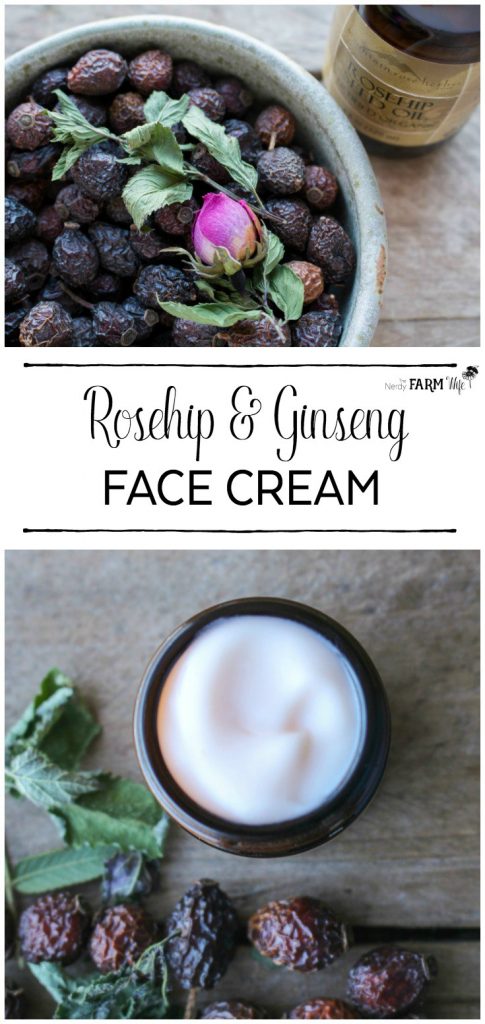

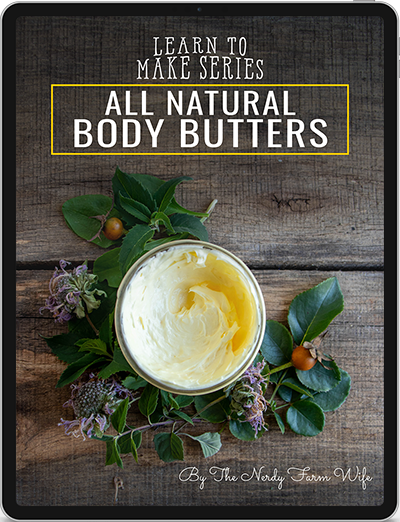

Sounds lovely, I was wondering, have you ever made a face ‘cream’ without water, e.g. Oil based so you don’t need the preservative please?
Hi Anna! I love using this whipped rose body butter as a nighttime face cream in winter. It’s rich, so a little bit goes a long way.
https://thenerdyfarmwife.com/wild-rose-body-butter/
Since there’s no water in it, you don’t need a preservative.
I am going to surprise my wife with your book. She follows your website and loves to make your products which I benefit from too.
Aw thanks Rex!! I hope she likes it! :)
I had trouble with my cream separating. It turned watery. Never had that happen before. Any ideas.
Hi Angie! What brand of emulsifying wax did you use? That’s my first thought as the potential culprit for separation. Did you make sure that the oil/wax portion and the water portion were nice and hot too? If you let me know – I can help you troubleshoot further from there. :)
I used Soaper’s Choice emulsifying wax. I’m going to try it again to see what happens. I think what it did is called separating. It had water standing in the cream. Not much but when you went to use it you could see water and pour water out. Is that separation?
Hi Jan, I posted a comment under the preservative blog but I don’t see it now. Maybe I didn’t actually post it. Hmm. Well, I thought your preservative tests were great and VERY useful.
What I also asked was have you considered using your ginseng extract/tincture? It should be the same I would think. I have some ready now to strain. I think I’ll try it now when I make this recipe.
Thank you so much for all your recipes. I have learned a lot from you and can’t wait for your book to get here!!!!
Hi Ann Marie, I’m so happy that you’re looking forward to the book and enjoy the recipes too! :) It sometimes takes me a couple of days to get comments answered – sorry about that! I did see and answer that one a few minutes ago and I really like your idea of trying a ginger tincture. I’d love to hear how your experiment goes! The only thing I can think of is that alcohol can be drying in excess, so you’d probably only need a few drops to be effective, maybe? Keep me posted how it goes!
Hi Jan again,
So I made the face cream today. However…I changed it quite a bit. I used the total amounts/grams of oils and E.wax etc. which I was so thankful to get because I’ve been wanting to make a small amount of face cream for so long but wasn’t sure what proportion to use. I used wheat germ, meadowfoam, jojoba, argan oils plus shea butter and Vit. E. I used optiphen because that’s what I have on hand. And, I did add the ginseng tincture 1/2 tsp, it really is so little alcohol that I can’t imagine that it’ll be that drying but I’ll see over time. I used a tiny bit of alkanet root powder but even that was too much, made it darker than I wanted. I also used rose hydrosol in place of some of the water and an EO blend that I love with rose, patchouli, palmarosa, geranium and sandalwood. The feel, texture and consistency are really nice.
I hope I haven’t gone on too long but I thought I’d share what I did. Thank you for your inspiration! I’m thrilled to have found your site. (I found your response. I just had to refresh! ) Thank you.
Oh what a wonderful sounding lotion – thank you for sharing how you made it! I bet it feels and smells so lovely! I’m happy that you’re enjoying the site too! :)
Hi Jan,
I have recently just started making lotions and have come to the conclusion that to be on the safe side I need to use a preservative (even though my lotion is aloe based not water based). I really want to use a preservative that is an close to natural as possible….would you mind telling me what preservative is your favorite right now? (using for lotions and sugar scrubs).
I greatly appreciate it and wish you nothing but amazing success on your upcoming book! :)
Hi Brooke! Thanks for the well wishes on the book! :)
I’m currently loving Luecidal Liquid SF. I wrote up a detailed post about my experiments with nature-derived preservatives that you might enjoy reading!
https://thenerdyfarmwife.com/natural-preservatives-for-homemade-lotion-and-cream/
Jan to save on expense of those amber jars, can this be put into small plastic pots like for lip gloss?
Hi Annie! Yes, you could keep this cream in lip gloss pots. Just no metal tins, since water-based creams will lead to rust over time.
Love you site, by adding the preservative can you still say all-natural cream.
Thanks
Hi Natalie! All-natural is just a marketing term, so people use it in on all sorts of products (some good & natural, some not so good & natural!)
Some nature-derived preservatives are acceptable for organic products, so you’d probably want to look for those for your all-natural creams & lotions.
For example, Leucidal Liquid SF (my personal favorite) is:
– Naturally derived
– REACH Compliant
– Broad spectrum of antibacterial activity
– ECOcert approved ingredient in Certified Organic products
– On the Whole Foods Acceptable Premium Preservative List
http://www.lotioncrafter.com/leucidal-liquid-sf.html
So, I would feel completely comfortable using it in a natural product line.
You’d have to look into each one, to see if there are other options you may want to pursue.
Lotioncrafter has excellent information like that, with each preservative description you can explore on their website:
http://www.lotioncrafter.com/lotioncrafter-premium-ingredients-preservatives/
Jan, I was wondering if you have any experience with plaque psoriasis. I have it (very mild, thank goodness), but it has been flaring up and seems to be spreading. I am a beginner at all the DIY bath and body products, and I was wondering if you thought this might help, or if you have any recommendations as to what I might try. Let me know when you can.
Thank you,
Peachy, a loyal follower
Hi Peachy! I’m so sorry I missed seeing this comment before now!! One thing you could try for plaque psoriasis is pine tar soap or salve:
https://thenerdyfarmwife.com/pine-tar-soap-recipe/
https://thenerdyfarmwife.com/old-fashioned-pine-tar-salve/